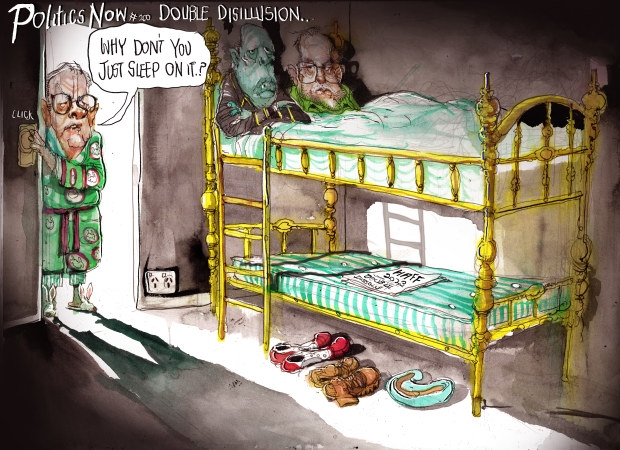Opinion

In one sharp move, Albanese puts Dutton and his naysayers on notice
The Prime Minister says that there will be no election this year. But he has a double dissolution trigger at a time when Labor is in an exceptionally strong position.
Laura TingleColumnistFederal politics feels like it has been marking time a bit over recent months.
Everyone’s been waiting for signs the economy is cracking under the weight of rising interest rates. But it hasn’t happened yet.
The debate on the Voice has gone round and round in an increasingly toxic circle, appearing to make not much headway.

A double dissolution trigger would give the Albanese government a broader range of options. David Rowe
Stories that have been around for years – particularly relating to the incompetence or mismanagement of the former government – flare again but aren’t quite resolved: robo-debt and repeated exposes of exorbitant contracts made with dubious companies to provide services to offshore processing centres are two of the most obvious examples.
The prime minister seems to have been out of the country doing a lot of talking to other world leaders.
That all changes with the return of parliament on Monday.
Anthony Albanese has signalled a return to a sharper political contest with his announcement that the government would be reintroducing the legislation for its Housing Australia Future Fund next week.
Since the Senate has already failed to pass this legislation once (or rejected it, according to the government), the signal in the prime minister doing this is clear: Dear Senate, pass this legislation or the government will have a trigger for a double dissolution election from October onwards.
There’s a lot of reasons you do this if you are the federal government. Some actually involve housing.
Housing – and rents – are without doubt in crisis in Australia, both in terms of availability and affordability.
Setting up this $10 billion fund to build social and affordable housing is Labor’s key policy for dealing with that crisis. So, it has every policy reason to want it through the parliament and funding housing construction.
But then there are all the other issues, and strategies, tied up in this move.
There’s the politics of being able to confront, and distant yourself from, the Greens, painting their opposition to the scheme as being part of what Labor calls the “No-alition”.
Until now, voters have not blamed Labor for rising rates or even the pressures caused by the cost of living.
That’s not without risks because the Greens have, to date, been able to do some policy differentiation of their own on housing, by calling for a more ambitious housing spend.
There’s the Labor dream of being able to win back seats – or some Senate spots – at an election if the government is riding high, lest those seats and spots become more firmly entrenched as Greens territory if they hold them for more than one term. For example, the three seats Labor lost to the Greens in Brisbane.
But more importantly than all this is the options a double dissolution election can give you between now and August next year which you might not otherwise have.
The government has been in the exceptionally rare position – for Labor – of being seen as both better on national security and the economy in recent times, as well as being well ahead of the Coalition on polling numbers.
The Coalition has been wearing – and will continue to wear – the opprobrium of debacles that happened on its watch, like robo-debt.
Revelations this week that Opposition Leader Peter Dutton, as home affairs minister in 2018, was briefed on a police investigation into alleged bribery one month before his department entered into a new contract with the target of that investigation will continue to reverberate when parliament returns.
Then there is the economy.
To date, it has held up better than expected. The jobs market has remained strong. The trajectory of inflation is now down – though the speed at which it falls further, back into the Reserve Bank’s target range, is not so clear.
There are signs the economy won’t necessarily keep going like that, including Friday’s weak retail sales figures.
The good news about those retail numbers is that they reinforce the view that the RBA does not need to lift rates again when it meets on Tuesday.
So, the prospects for the economy in the following months – optimistically – are that things will be slowing, but not catastrophically, and consumers and business will at least be reassured that interest rates aren’t going to go higher.
By the middle of next year most economists think we may actually see some rate cuts.
The pessimistic view would be that there is still the possibility that the economy will fall off the cliff, into recession, some time between the end of this year and the middle of 2024.
Until now, voters have not blamed Labor for rising rates or even the pressures caused by the cost of living.
The unexpected surplus of around $20 billion in 2022-23 revealed by Treasurer Jim Chalmers this week gives the government both some economic credibility and some flexibility to offer some more targeted cost-of-living relief between now and the next budget.
(If you were able to start a major home building scheme, that also wouldn’t hurt the prospects of propping up the economy either.)
But the very large range of those scenarios would mean you would want to have some flexibility about when you can call an election.
The prime minister said on Friday that voters “won’t be going to the polls this year”.
But just so that everyone is clear about his intent, he said, “the way in which you rule out having a double dissolution election is to have no triggers, that’s the way that you rule it out. I want this legislation to be passed. I can’t be more serious”.
Voters might not be going to a double dissolution election this year. But they are still likely to vote in a referendum on an indigenous Voice to parliament in October – and the results of that vote will also obviously have an impact on election timing.
The Australian Financial Review’s Phillip Coorey reported on Friday extensive in-depth polling by the Yes case, and Labor, in recent times which presents a much less pessimistic view of the success of the referendum than most published polls.
The prime minister has signalled a short, sharp official campaign on the Voice. But the arguments for now seem bogged down in treacle and are struggling to persuade undecided voters.
Some of the best arguments supporting the Voice emerged this week from the unlikely quarters of the Productivity Commission.
It was even more unlikely because the PC was reviewing a deal made by Scott Morrison as prime minister in 2020.
He said at the time that the reason Closing the Gap targets weren’t being met was because they were “never a partnership with Indigenous people”.
“We believed we knew better. We don’t,” he said.
He set up a new agreement with community-controlled peak Indigenous organisations to “do it differently by working together”.
The Productivity Commission is scathing of governments’ collective moves to live up to this agreement and notes that a crucial role for bodies, federal and state, like the Voice, could be in providing the data, and the scrutiny, of what governments are actually doing which would improve outcomes for Indigenous people, and reduce their costs.
“We know that when Indigenous people have a say in the design of programs, policies and services, the outcomes are better – and lives are changed,” Scott Morrison said in 2020.
How times, and politic arguments, change.
Introducing your Newsfeed
Follow the topics, people and companies that matter to you.
Find out moreRead More
Latest In Federal
Fetching latest articles